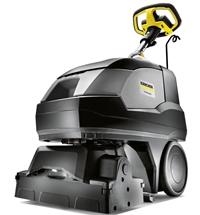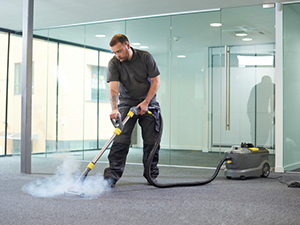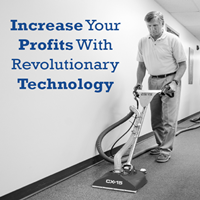
Carpet in hospitality facilities takes the brunt of spills and splatters from a variety of sources. With quick action, you can often completely remove stains caused by beverages, food, and bodily fluids. But what if the stain has been allowed to set for a few days before your cleaning team arrives?
Encountering a days-old stain is no reason to panic, although it might take a bit more effort to remove it, according to Marty Jollette, vice president of training and operations for Renue Systems, a leading provider of deep cleaning services to the hospitality sector.
“If you get to a stain on synthetic or wool carpet right away, cold water will often remove most of it,” Jollette said. “If the stain has had a chance to set, then you will need more of an effort to remove it.”
Lift organic stains
Not surprisingly, organic stains from food and beverages, such as coffee and red wine, are very common in hospitality facilities. “We see a lot of drink spills,” Jollette said. “We also see quite a bit of pet urine, because hotels are accommodating people with four-legged travel companions.”
If flushing the carpet with cold water is not effective, Jollette recommends switching to chemical stain removers such as oxidisers and reducing agents. Oxidisers add oxygen to the stain, and reducing agents remove oxygen. “If one doesn’t work, you can try the other,” Jollette said.
These chemicals are effective in removing tannins, which give many food and drink items their colour. For stubborn stains, try a heat transfer method after applying the chemicals: Place a damp, white cleaning towel on top of the stain, then rest a clothing iron at its highest setting on top of the towel for 30 seconds. The heat will draw the stain from the carpet into the towel.
This heat transfer method also works on the acid dyes used in decaffeinated coffee to replace the colour from the tannins in caffeine.
Bodily fluid carpet stains are also commonly found in hotels and other hospitality facilities. The removal process just described will work with these stains. “We have had good success with this process when we get a call to deal with a stain that has been in the carpeting for some time,” Jollette said.
Alkaline-based chemicals can also be effective for removing protein-based organic stains, such as blood and urine.
Clean beyond the surface
Sometimes stain removal is complicated because the staining agent has penetrated the surface of the carpet into the padding—or even further. “If housekeeping doesn’t see the stain for a day or even longer, it may absorb all the way into the concrete below the padding,” Jollette said.
In cases like these, after saturating the surface stain with the chemical, Jollette recommends injecting the chemical into all layers of the carpet to the floor below using a large hypodermic needle created for cleaning. “Inject the chemical, give it a chance to do its job, then flush it with water using a carpet wand, upholstery tool, or any tool you use for spraying water,” he said.
After flushing the stain, attach a water claw (sub-surface lifter) at the end of a vacuum hose. This tool will increase the vacuum’s lift, enabling it to extract the water and chemical from the floor, and draw the stain out of the carpet and padding.
Jollette stressed the importance of removing stains beyond the surface. If the stain remains in the padding, it can reappear on the carpet after it dries, even if the stain appeared to be gone the first time you cleaned the carpet. This reappearance is called wicking.
“You can reduce the likelihood of wicking—or remove wicking—by cleaning all layers of the stain,” he said.
Tackle other common stains and their odours
Oil-based stains such as those caused by paint, lipstick, candlewax, and chewing gum are other commonly found culprits on carpet in hospitality settings. Treat these stains with solvents, which break down oil and grease.
Another stain Jollette is seeing more frequently in hospitality settings is hair dye. Unfortunately, efforts to clean this stain do not always have a happy ending.
“We struggle a lot with men that dye their hair in hotels, because they will never dare do it at home due to stains,” Jollette said. “Hair dye is probably our biggest dye challenge. You can remove it to some extent, but it is almost near impossible to remove it completely.”
Along with leaving behind dyes, stains often leave behind odours. “When we come across jobs in banquet spaces where large trays of food have been spilled, we’re not only removing the spots, but also the odours,” Jollette said.
Jollette recommends using a deodoriser on large or especially odorous food stains. “There are some deodorisers that not only mask the smell, they contain oxidising agents that change the molecular makeup of odour molecules,” he said.
Don’t underestimate water
Sometimes overzealous cleaning can remove dye from carpet. “If you go too far, especially with the heat transfer process, you can damage the carpet fiber and remove the colour. You’ll need to use dyes to put the colour back,” Jollette said.
You might be able to avoid damaging carpet if your first step for removing a stain is trying cold water. “They call water nature’s solvent; it dissolves more substances than any other liquid,” Jollette said.
Even when set-in stains require chemical assistance, the final step should always include flushing the stained area with plenty of water.
“When you’re in this industry, there’s a million different chemicals you can use, but which come down to just a few different types, like oxidisers, reducing agents, alkalis, acids, and solvents,” said Jollette. “You always flush the stain with water after you put the chemical on it, then extract the water with a carpet extractor.”
This article originally appeared in the Cleaning & Maintenance Management publication and written by Kathleen Misovic.
Comment below to have your say on this story.
If you have a news story or tip-off, get in touch at editor@incleanmag.com.au
Sign up to INCLEAN’s newsletter.



